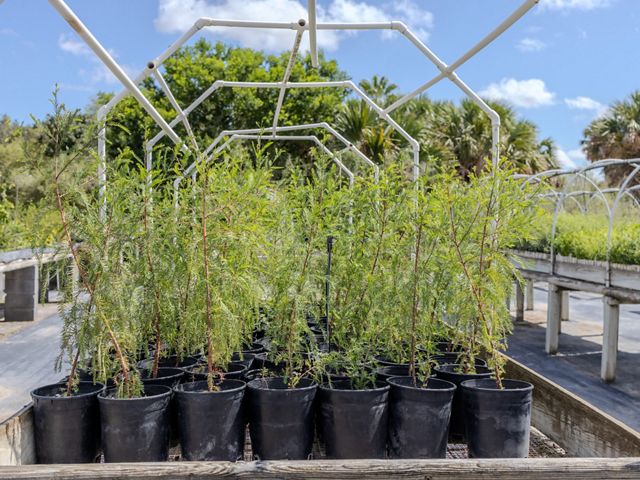Rooted in Restoration: An Opportunity to Build Back Montezuma Cypress
A love letter to the Montezuma cypress, the iconic national tree of Mexico, and its return to Texas.
Every year, University of Texas Rio Grande Valley (UTRGV) Professor Alejandro Fierro brings his students to The Nature Conservancy’s Lennox Foundation Southmost Preserve to work on research projects at the native plant nursery. Southmost Preserve is located on the U.S.-Mexico border and protects more than 1,000 acres of land along the Rio Grande. Its plant nursery produces tens of thousands of seedlings for area restoration efforts. Several student projects have focused on thornforest restoration, but at the suggestion of Professor Fierro, one study set out to restore Montezuma cypress (Taxodium mucronatum), a tree with great ecological and historical significance in the area.
What Makes the Montezuma Cypress Tree So Iconic?
The Montezuma cypress is a majestic conifer tree with massive trunks, spiral leaves and weeping branches. These spectacular trees grow near water; they provide habitat for wildlife, as well as shade, and they improve water quality. The Montezuma cypress has ancient beginnings that predate its namesake “Montezuma”—the ruler of the Aztec Empire (1502–1520) who had the trees planted in abundance in today’s Mexico City.
There are a few famous Montezuma cypress trees. El Arbol del Noche Triste in Mexico City is known as the tree that Conquistador Hernán Cortés cried under after losing a battle against the Aztecs in 1520. El Arbol del Tule in Oaxaca holds the record for the biggest diameter of 46 feet and is believed to be between 1,000 and 3,000 years old. School classes visit the tree and form a line to wrap their arms around it. Professor Fierro remembers being one of those schoolchildren himself.


Quote: Professor Alejandro Fierro
It’s a tree that I’ve known all my life. They are part of our forever environment. It’s a part of us, so when we were working with plants and seeds at the preserve, I thought, let’s look at this. Perhaps it will help in the propagation, re-establishment and recovery of the population in Texas.
A Historian Falls in Love
During the turn of the century, Montezuma cypress trees lined the banks of the Rio Grande Valley; accounts from Spanish and Mexican colonists in the area called the stands of cypress “boundless.” But that abundance began to diminish in 1846 with the start of the Mexican-American War. Historians approximate that 400 mature trees were clear-cut to build American General Zachary Taylor a temporary causeway.
Deforestation continued thereafter, escalating during the American Civil War in 1863 when Montezuma cypress were used to build a port and fuel the boilers of steamboats. And not long after that, the trees were used to construct three railroads. By 1919, where forests once thrived, only a few old-growth cypress trees remained at one site near the Mexico-U.S. border, on the Brownsville property of French immigrant Celestine Jagou, acquired in 1872.

In 2007, local Brownsville historian Eugene Fernandez heard about the old-growth trees. Mr. Fernandez paid a remaining Jagou heir a visit when she was in her late 90s. She told him to go down the carriage path and see the trees for himself.
“As I came into a clearing, I saw something in my peripheral vision to my left, and I glanced over at it and fell on the ground; I fainted,” said Eugene Fernandez, director of the South Texas Center for Historical and Genealogical Research. “If there had been a person nearby, they would have had to pour a bucket of water on me. I saw these most incredible cypress trees. I just was in awe.”

That was 15 years ago, a day that sparked Mr. Fernandez’s advocacy and love for Montezuma cypress. Since then, he helped ensure the old-growth site was protected by working to advance a deal that resulted in Ms. Jagou selling the cypress tract to the City of Brownsville. Mr. Fernandez also petitioned for the Montezuma cypress to be the official tree of the City of Brownsville, which was adopted in 2014.
In 2019, Mr. Fernandez advocated for the Texas Department of Transportation (TxDOT) to purchase 12 mature trees when TxDOT workers cut down two that had been planted in the 1920s. He planted the six-foot trees in visible spots around the Brownsville resaca banks. Currently, among other ongoing efforts, he is advocating for the name of the old-growth site to be called “Montezuma Cypress Preserve” (often currently referred to as La Posada del Rey).
Restoration Efforts at TNC’s Southmost Preserve
Sixty-nine trees remain at the old-growth site, the only natural stand remaining in the United States, according to Professor Fierro’s 2020 study. Among these magnificent trees, Professor Fierro, his students and TNC staff collected seeds to test their germination, bringing them back to TNC’s Southmost Preserve nursery to grow.
Quote: Sonia Nájera
The UTRGV research illustrates how Montezuma cypress seedlings can be effectively produced on a large scale, and with the old-growth seed source nearby, they can be produced efficiently at Southmost nursery. The next step? Connecting with the City of Brownsville to join forces and further efforts to restore the tree.



The Montezuma cypress trees planted by Professor Fierro and his students have grown from seedlings to 3- to 4-foot-tall saplings. The Nature Conservancy donated several sapling trees to The City of Edinburg and the South Texas Center for Historical and Genealogical Research. TNC Texas has been proud to partner with UTRGV to germinate and grow these important native trees that link together the natural and cultural history of the region.
We Can’t Save Nature Without You
Sign up to receive monthly conservation news and updates from Texas. Get a preview of Texas' Nature News email.








